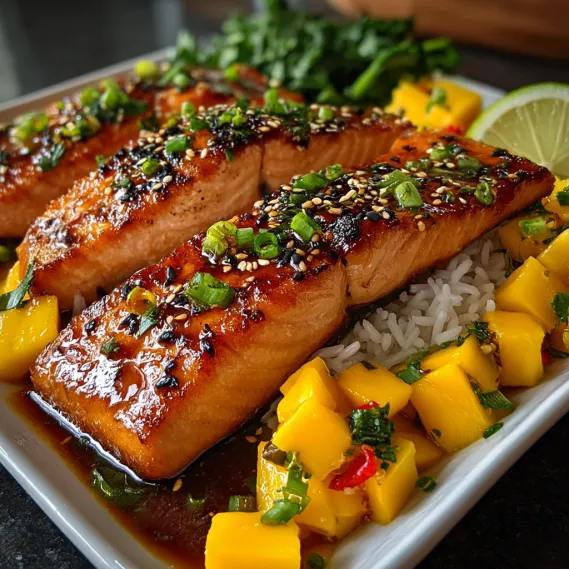 Pin
Pin
This mango teriyaki salmon transforms ordinary weeknight dinners into something extraordinary with minimal effort. The natural sweetness of mango pairs beautifully with savory soy and aromatic ginger for a dish that feels special but comes together quickly.
I first made this during a particularly hectic week when I needed something quick but didn't want to sacrifice flavor. The vibrant colors and tropical notes instantly brightened our mood, and it's since become our favorite way to make salmon feel special without much fuss.
Ingredients
- Salmon fillets: look for thick center cut pieces with bright color and firm texture
- Mango puree: provides natural sweetness and tropical flavor without being overwhelming
- Soy sauce: delivers umami depth and balances the sweetness
- Rice vinegar: adds necessary acidity to cut through the richness of the salmon
- Honey or maple syrup: enhances the caramelization and glossy finish
- Sesame oil: brings a nutty undertone that complements the fish beautifully
- Fresh garlic and ginger: provide aromatic foundation always worth using fresh
- Cornstarch: creates that restaurant quality thickness in the sauce
- Lemon juice: brightens everything and makes the flavors pop
- Sesame seeds and green onions: add textural contrast and visual appeal
Step-by-Step Instructions
- Create the Mango Teriyaki Base:
- Combine mango puree soy sauce rice vinegar honey sesame oil minced garlic and grated ginger in a saucepan over medium heat. Stir frequently to prevent the sugars from burning and allow the flavors to meld together for about 2 minutes. The mixture should be fragrant with the ginger and garlic becoming aromatic.
- Thicken the Sauce:
- When the base is well combined and simmering gently stir in the cornstarch slurry in a slow stream while whisking constantly. Continue cooking for 2 to 3 minutes until the sauce coats the back of a spoon. You'll notice it transform from slightly watery to a glossy glaze with body. Remove from heat immediately to prevent over thickening.
- Prepare the Salmon:
- Place your salmon fillets skin side down on a parchment lined baking dish leaving a small space between each piece. Generously brush each fillet with the mango teriyaki sauce making sure to cover the entire exposed surface. Reserve about half the sauce for serving.
- Bake to Perfection:
- Slide the salmon into your preheated 400°F oven and bake for 12 to 15 minutes. The exact time depends on the thickness of your fillets. Look for the fish to turn opaque and flake easily with a fork while still maintaining moisture in the center. For medium doneness the center should be slightly translucent.
- Final Flourish:
- Once the salmon is done transfer to serving plates and drizzle with additional warm sauce. Squeeze fresh lemon juice over each portion and sprinkle with sesame seeds and sliced green onions. This final touch adds brightness texture and visual appeal.

The mangoes are truly the star of this dish. I discovered this combination almost by accident when I had overripe mangoes that needed using. The natural enzymes in mango actually help tenderize the salmon slightly, creating an almost melt in your mouth texture that my family absolutely raves about.
Sauce Versatility
The mango teriyaki sauce works beautifully beyond just salmon. Try it brushed onto chicken thighs before grilling or as a glaze for roasted vegetables. I often make a double batch and keep it in the refrigerator for quick flavor boosts throughout the week. The sauce thickens when chilled but returns to the perfect consistency when gently warmed. For an easy appetizer option use it as a dipping sauce for spring rolls or drizzled over seared tofu for a vegetarian main.
Make Ahead Tips
While salmon is best cooked just before serving the sauce can be prepared up to five days in advance. Store it in an airtight container in the refrigerator and simply reheat when ready to use. If you need to prepare the entire dish ahead you can bake the salmon until it is just underdone about 10 minutes then refrigerate. When ready to serve reheat in a 300°F oven for 7 to 8 minutes with a fresh application of sauce. This prevents the salmon from becoming dry or overcooked.
Serving Suggestions
This salmon pairs wonderfully with simple coconut rice which carries through the tropical theme. Just substitute half the cooking water with coconut milk and add a pinch of salt. For a complete meal consider steamed bok choy or sugar snap peas alongside they provide a fresh crunch that contrasts beautifully with the tender salmon. During summer months I love serving this with a mango avocado salsa on the side for an extra burst of freshness. The colors on the plate are absolutely stunning making this perfect for entertaining.
Cultural Notes
This fusion dish draws inspiration from both Japanese teriyaki techniques and tropical flavor profiles. Traditional teriyaki combines soy sauce mirin sake and sugar but the addition of mango brings a Southeast Asian influence. In Hawaii similar combinations emerged naturally from the multicultural food landscape where Japanese cooking techniques met local tropical ingredients. This adaptable approach to cooking across culinary boundaries creates some of the most interesting and satisfying flavor combinations.
Common Questions About This Recipe
- → Can I use frozen salmon fillets?
Yes, just thaw the fillets fully before baking to ensure even cooking and optimal texture. Pat dry first for best results.
- → Is canned mango puree suitable?
Canned mango puree works well if ripe fresh mangoes are unavailable. Check that it's unsweetened to balance the sauce.
- → How do I know when the salmon is done?
Bake until the fillets flake easily with a fork. The flesh should be opaque and moist, usually 12–15 minutes at 400°F.
- → Can I grill the salmon instead of baking?
Grilling is a great option—just brush the mango teriyaki glaze on before and during grilling, using indirect heat for best results.
- → What sides pair well with this dish?
Steamed jasmine rice, sautéed greens, or roasted vegetables balance the flavors and complete the meal beautifully.
- → Can other fish be used with this glaze?
Certainly—try it with trout, cod, or halibut. Adjust cooking times as needed based on fillet thickness.
